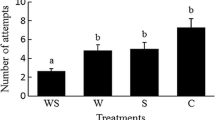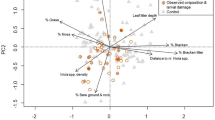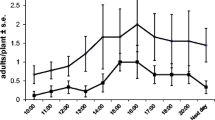Summary.
Aphid colonies can reach high levels of abundance but last for short periods of time. The larvae of aphidophagous ladybirds (Coleoptera: Coccinellidae) that feed on these colonies might therefore suffer from starvation, which favours the occurrence of cannibalism and intraguild predation. Thus, the assessment of patch quality becomes crucial and it has been shown that female ladybirds refrain from laying eggs in the presence of an oviposition deterring semiochemical deposited by their larvae.
Adalia bipunctata (L.), Adalia decempunctata (L.) and Coccinella septempunctata L. are 3 sympatric species of ladybirds, which can co-occur in aphid colonies. As a consequence, their eggs and larvae are under threat, not only from cannibalism but also intraguild predation. Females should, therefore, also use the tracks deposited by heterospecific larvae to assess the quality of aphid colonies as oviposition sites. The expectation is that: 1- the strength of the reaction to each other’s larval tracks should be correlated with percentage habitat overlap and that 2- the reaction to conspecific larval tracks should be stronger than to heterospecific tracks. In order to test these hypotheses, females’ oviposition behaviour was analysed and a chemical analysis of the tracks of their larvae undertaken.
The results show that oviposition behaviour is not related to habitat overlap. Both species of Adalia react to tracks of their own larvae and those of C. septempunctata, but A. decempunctata reacted more strongly than A. bipunctata. C. septempunctata reacted very slightly to its own tracks but not to those of either species of Adalia.
The larval tracks are mainly composed of alkanes. Those of the two species of Adalia are qualitatively 100% similar and 60% so when the quantitative results are compared. They are, however, only 24–29% similar to those of Coccinella septempunctata.
Similar content being viewed by others
Author information
Authors and Affiliations
Corresponding author
Rights and permissions
About this article
Cite this article
Magro, A., Téné, J.N., Bastin, N. et al. Assessment of patch quality by ladybirds: relative response to conspecific and heterospecific larval tracks a consequence of habitat similarity?. Chemoecology 17, 37–45 (2007). https://doi.org/10.1007/s00049-006-0357-5
Received:
Accepted:
Published:
Issue Date:
DOI: https://doi.org/10.1007/s00049-006-0357-5




